Other Guides:
Vintage T-Shirts 101: eBay Shopping Guide
Vintage T-Shirts 102: Avoid buying a forgery.
Vintage T-Shirts 103: The Gallery of Tags.
 Our epic battle against fake vintage t-shirts continues. This time we’re going to have a little fun in the Defunkd laboratories by experimenting on some suspected forgeries purchased on eBay.
Our epic battle against fake vintage t-shirts continues. This time we’re going to have a little fun in the Defunkd laboratories by experimenting on some suspected forgeries purchased on eBay.
To highlight the differences, we’ll pit two questionable tees with the same design against each other. Both tees were also photographed under the exact same lighting conditions. With the exception of added visual indicators, neither have been retouched or altered in any fashion.
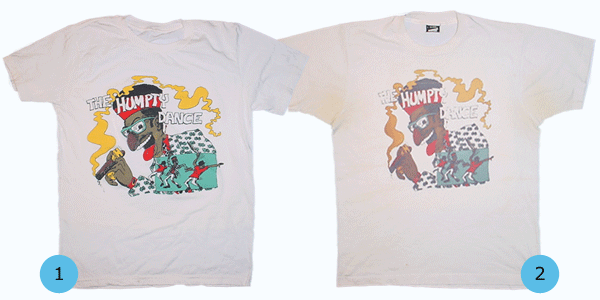
As outlined in our second t-shirt guide, the latest high tech t-shirt printing machines are one of the recent trends in creating forgeries. Many local print shops now carry t-shirt printing machines that print t-shirts on a one off basis. Here’s how it works: you provide a decent quality image, that image is formatted by the employees and transferred to the machine. A white t-shirt is placed in the machine, centered, and 5 minutes later you’ve got a t-shirt.
The end result can appear to be quite convincing in photos. Any loss in quality from the poor print process isn’t evident because the contrast of the photo is manipulated by the vendor and then reduced in size by eBay. Combine this with the fact that the persons behind these forgeries are using actual vintage t-shirts to print on, so now they have a recognizable vintage brand (as detailed in 3rd tee guide) and a previously worn shirt to help further legitimize the print. And of course the t-shirt is only one of many other vintage clothing items this vendor has for sale, the majority of which are real, which also lends credibility to the vendors products.
As always we suggest you shop with vendors who have stellar feedback ratings as detailed in our first t-shirts guide. However, if you buy your t-shirts at Defunkd you can rest assured our pre-screened vendors strictly deal in genuine vintage. If you decide to roll the dice elsewhere, use the information below to make a better decision, and then to test the item once it arrives or on questionable t-shirts you already have in your possession. And if it fails the test you can always file a PayPal dispute and try to get your money back.
The methods below will help you determine the difference between a t-shirt that has gone through the screen print process and one that has been printed using a machine.
It’s important to note that because of the method of printing, these t-shirt machines are only capable on printing on lighter colored shirts, and it’s suggested that you use pure white 100% cotton for the best results. Why is this you ask? A screen print is a rubber and ink substance that physically sits on top of the fabric so you can use it on any color t-shirt. The t-shirt printing machines dye the fabric by spraying inks that are absorbed in to it. If the fabric were black or other darker colors, there is less contrast between ink and fabric is lessened and the end result isn’t o effect on it.

A) The first test you can do on a suspected shirt to make sure it’s a screen print is run your fingers over the design. A screen print will have a physical rubbery like texture that becomes obvious when your fingers go from a blank area of the shirt to a printed area. If you close your eyes while doing it you can feel where the design begins. A shirt that has printed with a machine will not have raised ink because it has been absorbed in to the fabric.
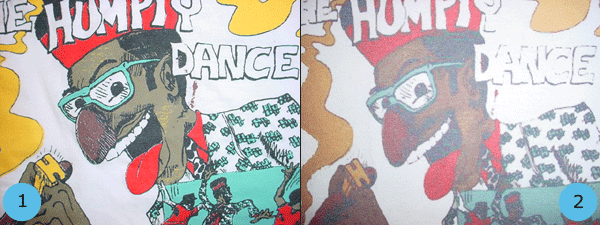 B) Another major indicator is the quality of the print. Most vintage t-shirts are a 50/50 poly-cotton blend, so when used in this forgery process there is an immediate loss in the quality of the print. The reason being that the synthetic polyester portion of the t-shirt will not absorb the ink sprayed from these machines. Couple that with the fact that persons behind this are usually getting the design from a shirt, and quality is always lost with this type of duplication.
B) Another major indicator is the quality of the print. Most vintage t-shirts are a 50/50 poly-cotton blend, so when used in this forgery process there is an immediate loss in the quality of the print. The reason being that the synthetic polyester portion of the t-shirt will not absorb the ink sprayed from these machines. Couple that with the fact that persons behind this are usually getting the design from a shirt, and quality is always lost with this type of duplication.
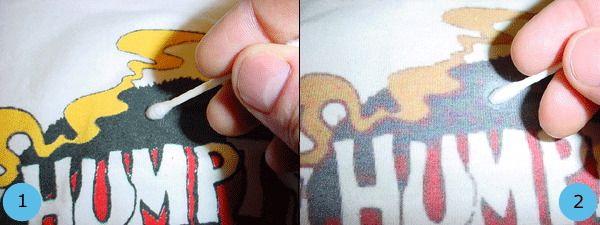
C) The final and best way to “spot” a fake? “It’s real easy to do, check it out” – Humpty.
If you still suspect you have a forgery on your hands after reviewing all of our guides proceed carefully at your own risk. We’re going to use bleach, so the test below should not be attempted on anything other than a pure white based shirt. And if the shirt you’re questioning is printed on a dark based tee, then for reasons previously described, you can be certain it wasn’t produced by one of these machines.
The best test to discover if your shirt isn’t a screen print is to dab a drop of bleach on the darkest portion of the design. A true screen print on white fabric will not be affected by bleach. But also note – some t-shirts from the early 1970s and decades previous actually used a similar ink process that modern day counterfeiters do. So despite being true vintage, will fail this test. As long as the fabric is pure white the ink formulation in the screen printing substance wont be discolored by bleach. While doing this be careful to put a tiny bit of bleach only the print, not letting bleach soak through to the rest of the shirt. After about 30 minutes the t-shirt machine ink print becomes obvious it’s a forgery. If your t-shirt passes the test, make sure to thoroughly rinse the fabric of residual bleach. If it doesn’t pass the test, use it as a dish rag.
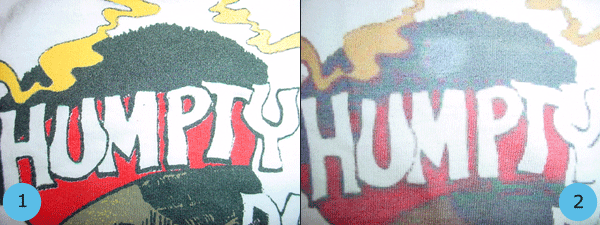 The end result? So #1 is a real vintage shirt right? Well, we determined that it was created using the screen printing process and the t-shirt on the right was created using a t-shirt printing machine. But truth be told both shirts are fake. The t-shirt on the left is a also vintage bootleg.
The end result? So #1 is a real vintage shirt right? Well, we determined that it was created using the screen printing process and the t-shirt on the right was created using a t-shirt printing machine. But truth be told both shirts are fake. The t-shirt on the left is a also vintage bootleg.
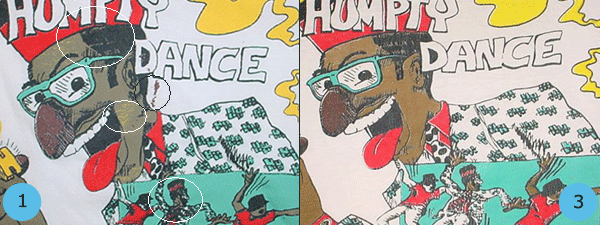
How do I know? I dug deep in the the Defunkd photo archives to find an actual vintage version of this t-shirt (#3) and you can see the differences in the print. When compared with #1 we see the colors and details aren’t accurate. The ink mishaps make it obvious that counterfeiter #2 used counterfeiter #1’s already poor quality image.
Unfortunately, there is no happy ending to this song. The problem is that if a seller really sets out to deceive us, we may never find out. Especially if they use a deadstock vintage branded t-shirt and put together an accurate screen print. The only way to determine if the article is real would be to date the ink used on the design, and that’s CSI level stuff. And yes, we’re working on it. In the meantime it’s best to just stick with shops who are operated by honest veteran t-shirt sellers.


![[ LINK IN BIO ] In honor of May the 4th we connected with a gentleman named Shawn whose father, Ira, worked for ILM. He designed the Biker Scout, need we say more? Shawn shared an epic tale of a bootleg Star Wars tee his dad heroically stashed away despite George Lucas' attempt to have it destroyed.
.
RIP Ira Keeler. Long live the resistance.
.
#vintagetshirt #vintagetee #vintagetees #vintagetshirts #maythe4th #maytheforth #starwarsday #georgelucas #starwarscollectibles #starwarscollectible #ILM #starwarscollection #starwarscollector #starwarscollectors #starwars #starwarsfan
#irakeeler](https://www.defunkd.com/newblog/wp-content/plugins/instagram-feed/img/placeholder.png)
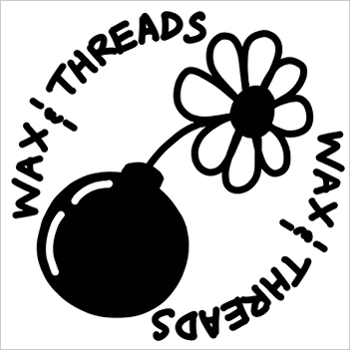
Pingback: Selling Vintage TShirts: How to Identify and Sell Collectible T Shirts
Pingback: The Story of Vintage Concert T-Shirts | เสื้อทัวร์วินเทจวงดัง มนต์ขลังที่ไม่เคยเสื่อมคลาย (Part 2) - SneakaVilla